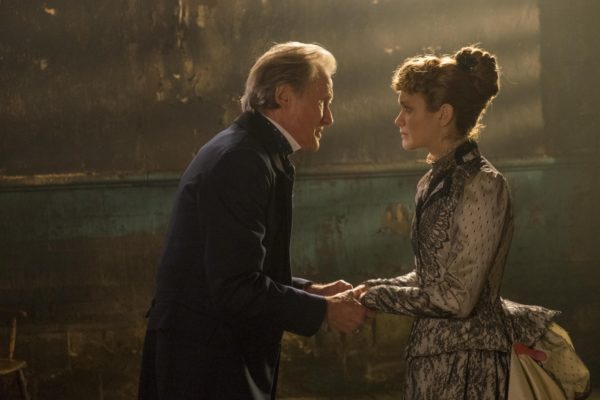One upside of the recent Downtonisation of British
cinema and TV – lacing-up history in pretty bows for easy export – has been the
rediscovery of a counter-strain of period horror. 2011’s The Awakening, 2012’s The Woman in Black, and small-screen scream Penny
Dreadful all cut a swathe through Empire’s underbelly, exposing the rot that
lurked behind the hope and glory. Now there’s The Limehouse Golem (***, 15, 109 mins), a curious melange born of
wildly diverse influences: turning Peter Ackroyd’s novel over to cackling Kick-Ass scribe Jane Goldman, Juan
Carlos Medina’s film attempts an altogether grisly cross-section of late 19th century London. You might want to brace (or at least cross) yourself.
The year is 1880, and we find the eponymous East
End murderer several kills into a reign of terror stirring press and public alike
into a frenzy. Bill Nighy’s marginalised Scotland Yarder Kildare is on the
case, yet he’s soon distracted by Lizzie Cree (Olivia Cooke), a doll-like music
hall performer accused of poisoning her playwright husband. Ackroyd’s thesis is
that, for pre-Netflix Britain, murder provided its own form of entertainment,
bestowing celebrity upon an infamous few. Much as there was speculation Jack
the Ripper had to have been well-connected, so too the Golem’s slayings throw
up illustrious suspects: Karl Marx (Henry Goodman), George Gissing (Morgan
Watkins) and Dan Leno (Douglas Booth).
Medina, meanwhile, gets starry-eyed over his
glitziest set – understandably so, as it plays host to the only gaiety and
warmth coming off the screen. Music hall (proto-cinema as it was) is here
positioned as an affordable escape from a grim world indeed: dark, dank and
crowded, shrouded in the noxious fumes of industry and intolerance, the film’s
London forms a theatre of cruelty in which a Lizzie Cree’s fate is to be sold
as trade or married off to brutes. (Death almost offers a relief.) This
distinguishes The Limehouse Golem from
the cosy Sunday-night telly that’s started sneaking into multiplexes: Medina’s
bloody backstreet meanderings owe more to Hannibal Lecter than nice Hugh
Bonneville.
It’s just a pity everybody’s locked into a plot
that’s never quite as richly detailed as Ackroyd’s historical backdrop. Nighy aces
a poignant coming-out scene with a young constable (Daniel Mays), only for
Goldman to retreat from Kildare’s inner life. The whole winds up seeming both
clever and strained: a race-to-the-gallows setpiece parallels an earlier staged
execution but feels hackneyed, and it cues revelations that may provoke groans
from the cheap seats. For all its literary trappings, the film’s finally a
penny dreadful itself, one that hooks and diverts yet brooks no lasting
scrutiny; still, given British cinema’s current, fustily perfumed state, a
pungent whiff of sulphur like this might just count as a breath of fresh air.
The Limehouse Golem is now showing in cinemas nationwide.

No comments:
Post a Comment